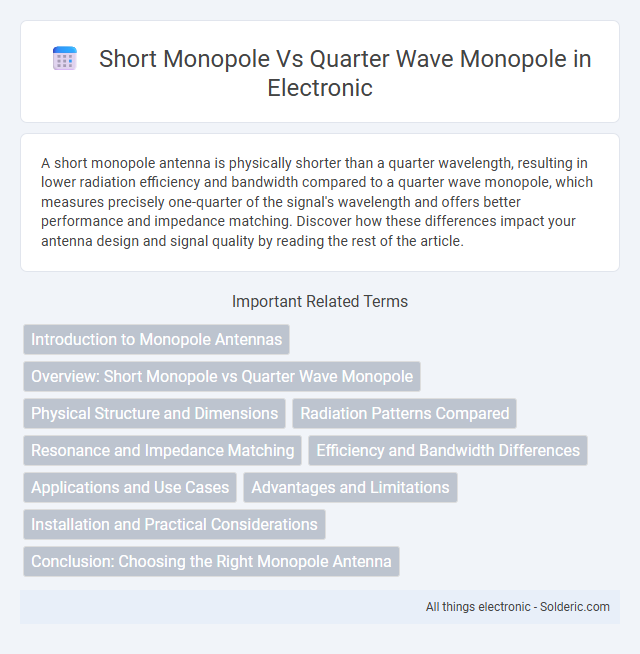A short monopole antenna is physically shorter than a quarter wavelength, resulting in lower radiation efficiency and bandwidth compared to a quarter wave monopole, which measures precisely one-quarter of the signal's wavelength and offers better performance and impedance matching. Discover how these differences impact your antenna design and signal quality by reading the rest of the article.
Comparison Table
| Feature | Short Monopole | Quarter Wave Monopole |
|---|---|---|
| Length | Less than 1/4 wavelength | Exactly 1/4 wavelength |
| Radiation Efficiency | Lower efficiency due to shorter length | High efficiency with optimal resonance |
| Impedance | Capacitive reactance; requires matching network | Resonant; impedance approx. 36.5O |
| Bandwidth | Narrow bandwidth | Wider bandwidth |
| Size | Compact, suitable for limited space | Larger due to quarter wavelength size |
| Applications | Portable devices, size-constrained installations | Base stations, fixed antennas |
| Gain | Lower gain | Moderate gain (~5.15 dBi) |
Introduction to Monopole Antennas
Short monopole antennas measure significantly less than a quarter wavelength, resulting in reduced radiation efficiency and narrower bandwidth compared to standard quarter wave monopole antennas, which are designed to be approximately one-quarter of the signal's wavelength for optimal resonance. Quarter wave monopoles exhibit better impedance matching and radiation patterns due to their length being a precise fraction of the wavelength, enabling efficient signal transmission and reception in various communication systems. The choice between short and quarter wave monopole antennas depends on size constraints and performance requirements, where quarter wave designs generally provide superior gain and bandwidth.
Overview: Short Monopole vs Quarter Wave Monopole
Short monopole antennas operate at lengths significantly shorter than a quarter wavelength, resulting in reduced radiation efficiency and bandwidth. Quarter wave monopole antennas measure approximately one-quarter of the signal's wavelength, offering better impedance matching, higher gain, and improved radiation efficiency compared to short monopoles. The choice between these antennas depends on design constraints, with quarter wave monopoles favored for performance and short monopoles used where size limitations are critical.
Physical Structure and Dimensions
Short monopole antennas are physically shorter than quarter wave monopoles, typically less than one-quarter wavelength in length, resulting in a compact structure ideal for space-constrained applications. Quarter wave monopoles measure precisely one-quarter of the radio wave's wavelength, providing a well-defined physical dimension that optimizes radiation efficiency. Your choice between these antennas affects the antenna's size, with short monopoles offering a smaller footprint but reduced performance compared to the longer, standard quarter wave design.
Radiation Patterns Compared
Short monopole antennas exhibit a broader, less directive radiation pattern with lower gain compared to quarter wave monopoles, which produce a more focused and efficient omnidirectional pattern. The quarter wave monopole's radiation closely approximates an ideal vertical dipole, resulting in stronger signal strength especially at lower elevation angles. Your antenna choice impacts coverage area and signal clarity significantly due to these radiation pattern differences.
Resonance and Impedance Matching
Short monopole antennas resonate at frequencies below their physical length, resulting in lower radiation efficiency and capacitive reactance that complicates impedance matching. Quarter wave monopole antennas achieve resonance at a length equal to one-quarter of the wavelength, providing a purely resistive impedance close to 36.5 ohms ideal for direct matching to typical 50-ohm transmission lines. Impedance matching for short monopoles requires additional components such as loading coils or capacitors to cancel reactance, while quarter wave monopoles inherently facilitate efficient power transfer due to natural resonance.
Efficiency and Bandwidth Differences
Short monopole antennas typically exhibit lower efficiency due to reduced radiation resistance and higher capacitive reactance, causing increased power loss. Quarter wave monopoles offer improved efficiency by operating near resonance, resulting in lower reactance and better radiation resistance. Bandwidth is generally narrower in short monopoles, while quarter wave monopoles provide wider bandwidth, enhancing signal quality and overall performance for your communication needs.
Applications and Use Cases
Short monopole antennas are commonly used in compact wireless communication devices where space and size constraints are critical, such as in handheld radios and mobile phones. Quarter wave monopole antennas are favored in applications requiring better efficiency and longer range, including base stations, vehicle-mounted systems, and broadcast transmitters. Your choice depends on balancing size limitations with performance needs in specific communication environments.
Advantages and Limitations
Short monopole antennas offer compact size and ease of installation, making them ideal for space-constrained applications, but they suffer from lower efficiency and reduced radiation resistance compared to quarter wave monopoles. Quarter wave monopole antennas provide better impedance matching and higher gain, resulting in more effective signal transmission and reception, though they require a longer physical length that might not be feasible in all environments. Your choice depends on balancing the trade-off between antenna size and performance based on the specific requirements of your communication system.
Installation and Practical Considerations
Short monopole antennas require less physical space and simpler mounting structures, making installation easier in confined environments compared to quarter wave monopoles. Quarter wave monopoles, due to their longer length, often need more robust supports and precise grounding, affecting practical deployment. Your choice should consider available space and structural support to ensure optimal performance and stability.
Conclusion: Choosing the Right Monopole Antenna
A quarter-wave monopole antenna offers optimal performance with its resonance at a specific frequency, providing better radiation efficiency and bandwidth compared to a short monopole. Short monopole antennas are physically smaller but typically require loading coils to achieve resonance, which can introduce losses and reduce overall efficiency. Your choice should balance size constraints and performance needs, with quarter-wave monopoles favored for higher efficiency and short monopoles suited for compact applications.
short monopole vs quarter wave monopole Infographic

 solderic.com
solderic.com